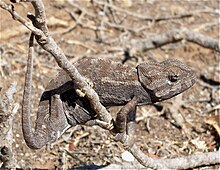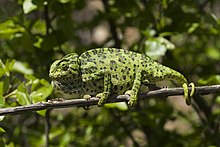Ordinary chameleon
| Ordinary chameleon | ||||||||||||
|---|---|---|---|---|---|---|---|---|---|---|---|---|

Common chameleon ( Chamaeleo chamaeleon ) |
||||||||||||
| Systematics | ||||||||||||
|
||||||||||||
| Scientific name | ||||||||||||
| Chamaeleo chamaeleon | ||||||||||||
| ( Linnaeus , 1758) |
The common or European chameleon ( Chamaeleo chamaeleon ) lives in North Africa along the coast of the Mediterranean , in Israel , Jordan , Syria , Lebanon, and southern and western Turkey . There are only a few isolated occurrences in Europe. It lives in the south of the Iberian Peninsula in the Portuguese province of Faro and in the Spanish provinces of Huelva , Cádiz , Málaga , Granada and Almería , on Malta , Crete , Chios and Samos . The chameleons in the south of the Peloponnese are not European, but the larger African chameleons ( Chamaeleo africanus ). The European occurrences are probably due to human introductions. They are threatened with extinction.
habitat
Ordinary chameleons live mainly in coastal areas rich in vegetation, such as well-planted dunes, but also in light forests and bushland, often near water. In North Africa they are also found alive on the ground in areas with little vegetation, in the province of Málaga they are still found at altitudes of 900 meters, outside Europe at altitudes of 2,600 meters. On the Iberian Peninsula , the common chameleons are cultivators that can also be found in olive groves, eucalyptus plantations, agricultural plantations and gardens that are regularly sprayed with water. In their habitat, temperature differences between day and night of up to 40 ° C can occur.
features
Common chameleons grow to be eight to eight inches long. Usually they reach a length of 25 centimeters, of which ten to twelve are accounted for by the prehensile tail. Your body is high back and flattened on the sides. There is a low crest on the back and a noticeable, helmet-like bulge on the back of the head. As with all chameleons, their toes are partially fused into gripping pincers and the protruding eyes can be moved independently of each other. The common chameleon is usually light or olive green, with two irregular, white longitudinal bands, but can change color quickly and turn gray, blackish, or brown with black spots. At night the animals are light brownish-gray, when excited they become more contrasting.
Reproduction
Common chameleons mate between August and September. The female lays 20 to 50 eggs in self-dug holes in the ground in October or November at the beginning of the cooler, rainier season, 40 to 60 days after mating. The eggs are 10 to 19 × 8 to 12.5 mm in size. The development of germs is dormant during winter. The young hatch after eight to nine months in July or August of the following year.
swell
- Manfred Rogner : Lizards. Keeping, care and breeding in the terrarium. Volume 1: geckos, pinnipeds, agamas, chameleons and iguanas. Ulmer, Stuttgart 1992, ISBN 3-8001-7248-8 .
- Günter Diesener, Josef Reichholf : amphibians and reptiles (= Steinbach's natural guide. ). New, edited special edition. Mosaik Verlag, Munich 1996, ISBN 3-576-10697-9 .
- Axel Kwet: Reptiles and Amphibians of Europe. Kosmos, Stuttgart 2005, ISBN 3-440-10237-8 .
Web links
- Chamaeleo chamaeleon in The Reptile Database
- Chamaeleo chamaeleon inthe IUCN 2013 Red List of Threatened Species . Posted by: Vogrin, M., Corti, C., Pérez Mellado, V., Sá-Sousa, P., Cheylan, M., Pleguezuelos, J., Baha El Din, S. & Al Johany, AMH, 2012. Retrieved November 18, 2013.

